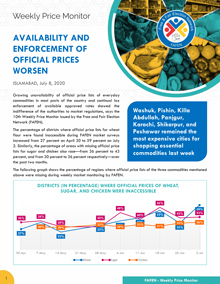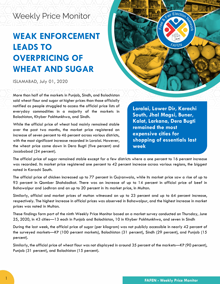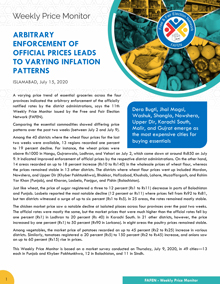- Washuk, Pishin, Killa Abdullah, Panjgur, Karachi, Shikarpur, and Peshawar remain most expensive cities for essentials’ shopping last week
ISLAMABAD, July 8, 2020: Growing unavailability of official price lists of everyday commodities in most parts of the country and continual lax enforcement of available approved rates showed the indifference of the authorities to market regulations, says the 10th Weekly Price Monitor issued by the Free and Fair Election Network (FAFEN).
The percentage of districts where official price lists for wheat flour were found inaccessible during FAFEN market surveys increased from 27 percent on April 30 to 59 percent on July 2. Similarly, the percentage of areas with missing official price lists for sugar and chicken also rose—from 36 percent to 43 percent, and from 30 percent to 36 percent respectively—over the past two months.
The following graph shows the percentage of regions where official price lists of the three commodities mentioned above were missing during weekly market monitoring by FAFEN.
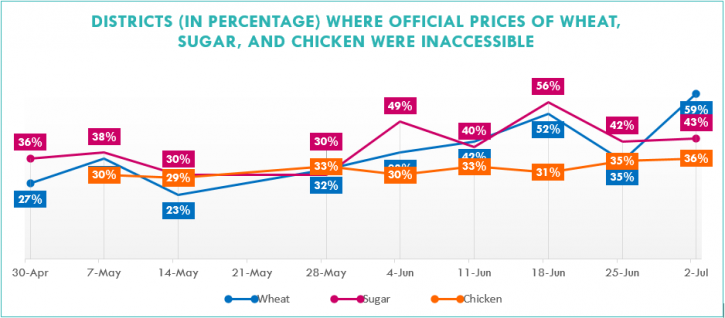
Comparing the three commodities with the most volatile prices—wheat flour, sugar, and chicken—showed a changing price trend over the past two weeks (between June 25 and July 2).
For a 20-kilogram bag of wheat flour, the gap in the wholesale market and official prices appeared to lessen in Multan, Liaquatpur area of Rahimyar Khan, and Jhal Magsi, indicating improved enforcement by the administration in these districts. However, seven other regions, including Washuk, Panjgur, Lasbela, Battagram, Mardan, and Muzaffargarh, recorded one percent to 15 percent increase in the wholesale price of the 20-kilogram wheat flour bag. In 21 districts, the wheat flour prices remained stable.
Just like wheat, the price of sugar registered a three to six percent (Rs3 to Rs5) decrease in parts of Balochistan and KP, including Dera Bugti, Lasbela, Washuk, Lower Kohistan, and Upper Dir. But it recorded a surge of up to 13 percent (Rs10) in some Sindh districts, including Larkana, Qambar Shahdadkot, Dadu, and Badin. In Punjab, the sugar price remained mostly stable or recorded a slight increase of one percent except for an 11 percent (Rs8) increase in Rahim Yar Khan since June 25.
The chicken market price saw a notable decline at isolated places across four provinces over the past two weeks. The official prices were mostly the same, but the market prices that were much higher than the official rates fell by two percent (Rs5) in Malakand to 32 percent (Rs 90) in Qambar Shahdadkot. In 14 other districts, however, the chicken price increased by one percent (Rs2 in Lodhran) to 22 percent (Rs40 in Karachi South).
The current Weekly Price Monitor is based on a market survey conducted on Thursday, July 2, 2020, in 56 cities—18 in Balochistan, 15 in Punjab, 13 in Khyber Pakhtunkhwa, and ten in Sindh.
The officially notified price lists of various commodities are becoming increasingly inaccessible. During the reporting week, the official prices of 20-kilogram wheat flour bags were unavailable in around 59 percent of the surveyed cities. The week before that, the official wheat prices were missing in only 35 percent of districts. However, they were unavailable now across the country. The most notable provinces being Khyber Pakhtunkhwa and Sindh, where 85 percent and 70 percent of the surveyed markets did not display the official rates for wheat flour.
The official sugar prices were missing in 43 percent districts—92 percent in KP, 33 percent in Balochistan, 27 percent in Punjab, and 20 percent in Sindh. Similarly, the chicken prices were not obtainable in 36 percent districts overall—67 percent in Balochistan, 60 percent in Sindh, and 15 percent in KP.
The official rates of four pulses—moong, masoor, mash, and channa—were not available in 11 percent to 16 percent of the surveyed markets. At the same time, the prices of milk and yogurt were not publicly obtainable in 21 percent and 30 percent districts, respectively.
Moreover, mutton and beef prices were missing in 13 percent and 11 percent of the districts. The official price lists of regular vegetables—potatoes, onions, and tomatoes—were found inaccessible in around 20 percent of the Sindh markets and 28 percent of markets in Balochistan. Punjab did well in making available the official prices of vegetables, poultry, and pulses through its Qeemat Punjab app.
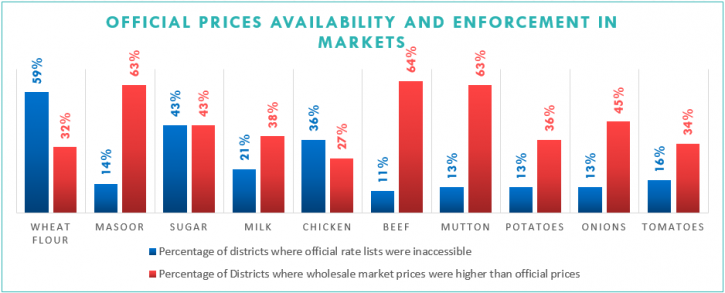
Weak enforcement of official prices inconvenienced ordinary citizens as traders sold several commodities at higher rates than the officially notified prices. Among the routine commodities, the implementation of official prices was the weakest in the case of pulses and meat. Daal masoor was overpriced in 63 percent of the surveyed districts, moong in 57 percent, channa in 54 percent, and mash in 52 percent of the areas. These four pulses went Rs118 to Rs193 above the official price. Like previous weeks, Karachi South remained the most expensive city to shop for pulses.
Among the everyday vegetables, tomatoes, potatoes, and onions were overpriced in 34 percent, 36 percent, and 45 percent districts, respectively. The price of tomatoes went Rs50 higher than the notified rate in Jhal Magsi, while the potatoes and onions were sold Rs30 and Rs25 above the announced prices in Peshawar and Panjgur.
In the meat category, beef and mutton (average quality with bone) were overpriced in over two-thirds of the surveyed districts, and chicken in 27 percent areas. Mutton, beef, and chicken were priced at Rs929, Rs369, and Rs102, respectively, above the official rates. Karachi remained the most expensive market for mutton, beef, and chicken last Thursday. Traders sold wheat flour and refined sugar above the official rates in 32 percent and 43 percent districts. A 20-kilogram bag of wheat flour was priced Rs300 above the official rate in Washuk, and refined sugar Rs21 more than the market price in Karachi South.
The market rates of eggs per dozen were above the officially notified prices in 30 percent districts. At the same time, the prices of milk and yogurt were higher than the official rates in 38 percent and 32 percent of the surveyed areas.
TDEA-FAFEN generates the Weekly Price Monitor covering 15 essential kitchen items, including groceries such as wheat, pulses, oil, sugar, and perishable commodities like meat, and vegetables. It does this considering the need for an independent and regular assessment of the availability of such items.
The observers obtain the official prices from the officials of district administrations, or market committees, and collect the wholesale prices through market surveys. In Punjab’s case, the government price app Qeemat Punjab is also used to get the official rates.
To download the report, click here

